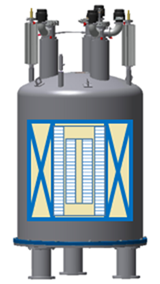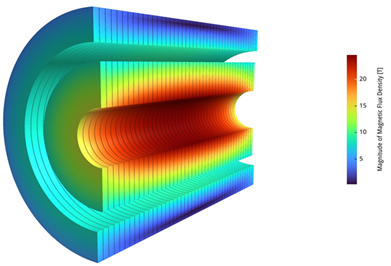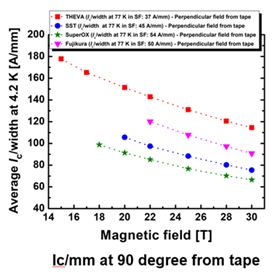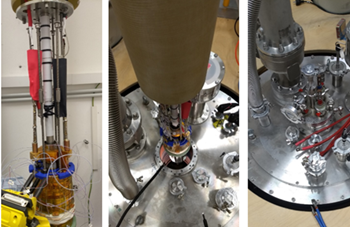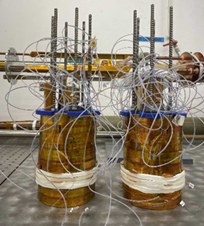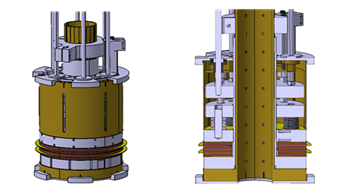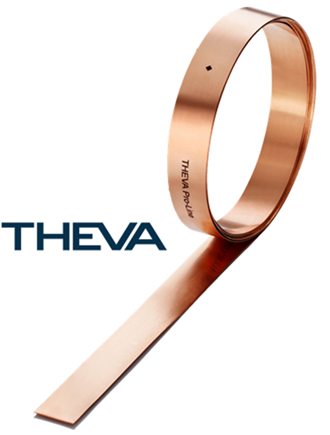Objectives
1. Define appropriate specifications
Homogeneity, stability and bore size according to the users requirements with two targets 32+T and 40+T all-superconducting magnets
Achievements
We have developed a series of simulation tools that led to a preliminary design for various HTS inserts with a fairly wide range of options to prioritize homogeneity, peak field or bore size according to user requirements. Most users require a 4K bore of typically 20-40mm with the ability to go to higher or lower temperatures using suitable inserts. The maximum field should be as high as reasonably possible; both a 32-T and a 40-T magnet would be highly requested by users. In particular, compared to the use of resistive DC magnets, by utilizing the much better field stability and the ability to remain at a large field for a longer period of time, the research yield of high magnetic field research can be significantly improved. The required homogeneity for most users is on the order of 10E-3 (1000 ppm) in 1 cubic cm, although specific applications may require a better homogeneity.
2.Produce a complete design
Complete magnet design including a failure mode analysis and a risk assessment of the 32+ T and the 40+ T all-superconducting user magnets, and including HTS technology in its center with a field strength significantly above the state-of-the-art.
Achievements
After a phase of parametric studies and optimization processes in order to define the geometry for the HTS insert, the protection of the full magnet system has been evaluated. Two arrangements were considered, both based on existing LTS magnets fabricated by Oxford Instruments (OI) used as outsert : first, a 19 T/ 150 mm version combined with a single solenoid HTS insert, and, second, a 15 T/ 250 mm version with a nested-coils HTS insert. This latter allows to generate more than 40 T in a 50 mm diameter bore. The quench protection of the HTS insert is based on the self-protecting feature of the metal-insulation co-winding technology (MI) and the voltage limitation of the power supply. Concerning the LTS part, a mechanical reinforcement was designed and added because of the strong axial forces generated during the quench of the HTS part. Concerning the first arrangement, a prototype version using an 19T/150 mm LTS outsert available at HZDR was successfully tested with a small but relevant sized HTS insert made of a stack of two double pancakes. As far as the second arragement is concerned, a proof-of-concept protoype, based on a small-scale design of the nested-coils 40 T N1a magnet, has been designed. It has still to be fabricated by Bilfinger and tested at CNRS/LNCMI.
3. Develop the complete characterization and qualification
Electrical, thermal and mechanical characterizations of HTS conductors and test coils close to operating conditions
Achievements
The main focus of HTS tape characterization was on the critical current density (Jc), which represents the maximum current density the material can carry dissipationless. In anticipation of the coils to be produced within the project, 6 mm wide tape samples from four manufacturers were characterized at 4.2 K, in magnetic fields up to 30 T, and under various orientations. Additional tape qualification tests investigated their mechanical behavior (maximum tolerated strain during coil winding, cooling and powering; risk of delamination at joints and terminations) as well as the thermal- and electrical conductivity from turn-to-turn within the coils (relevant for coil ramping losses; for thermal stability; and for quench dynamics).
This characterization process was iterative, with feedback from the suppliers. For example, the project partner Theva (TH) delivered three “generations” of tape material (initial short samples for validating the Jc-enhancing ‘artificial pinning’ process; longer lengths in September 2022 showing some delamination issues; and reinforced lengths delivered in January 2024).
Test coils made from a stack of two ‘double pancake’ coils are dedicated for evaluating each HTS tape under conditions close to operation, in a background field of 20 T at CNRS-LNCMI or 19 T at HZDR. A first test coil made from Theva’s tape showed performance limitations due to delamination. New test coils using tapes from different suppliers, Theva (reinforced), SST, and Fujikura, were fabricated. Their tests will provide comparison between tapes and with former experiments, contributing to the mitigation of risk associated to HTS tape procurement as well as to a better understanding of the impact of different performances.
4. Demonstrate the feasibility
Assessing technological challenges (interactions HTS/outsert LTS, quench, mechanics …) through modeling and tests
Achievements
The SuperEMFl partners jointly demonstrated the feasibility of 32+ T and 40+ T all superconducting magnets.
Design and quench protection: CEA, Institute of Electrical Engineering (IEE) and Oxford Instruments (OI) focused on implementing modelling tools for calculating pre-designs and optimizing their essential design parameters (e.g. conductor length, maximum field, inner diameter) and assessing them from scientific users’ point of view. Specific simulations were performed combining large LTS magnets (such as the 19T/150mm magnet at HZDR made by OI) and HTS high-field inserts with large inductive energy. Hereby, the partners analyzed protection and quench scenarios. The strength of mutual forces between the HTS and LTS magnet sections in case of an asymmetric HTS quench case were found to be particularly critical. For that reason, OI has reinforced HZDR’s 19 T LTS magnet and proven its functional integrity for critical HTS/LTS tests in future .
Quench test experiments: CNRS has prepared and tested a series of small and low inductive two-double pancake (2DP) HTS coils at moderate stored energy in a background field provided by resistive magnets at CNRS/LNCMI. CNRS has also refurbished and characterized an HTS insert that reached once 32.5 T in HTS and resistive background field configuration. CNRS conducted high-resolution field-stability experiments by means of NMR and identified the formation of helium gas bubbles trapped by a large magnetic field gradient as a challenge for stable operation of all-superconducting magnets. HZDR developed and equipped its LTS magnet with an LTS/HTS interface assembly, power and measurement electronics as well as software for control and data acquisition of LTS/HTS test experiments. HZDR performed tests on 2DP HTS coils. During a quench test of the second HTS coil, the project partners have also observed a quench of the outer LTS magnet.
5. Develop requirements for fabrication
Assessing the manufacturing compatibility with an industrial environment
Achievements
Another key achievement of the project is to ready the European industry to produce cutting edge magnet systems as designed and requested as a product within an industrial environment.
To achieve this, CNRS/LNCMI and CEA contributed by their innovative developments on metal-as-insulation (MI) HTS magnets to a knowledge transfer program with BIlfinger to enable the industrial manufacturing of an HTS high magnetic field insert. In parallel, extensive cooperation with OI, CEA, HZDR and IEE has led to the development of an advanced LTS outsert magnet capable of producing the desired background magnetic fields with the necessary mechanical robustness to achieve fields of up to 40 T.
The work included the production of HTS sample coils by CNRS and Bilfinger. The test of HTS coils in existing LTS outsert magnets to study the behaviour and interaction of coils during operation and quench. The derived results are feeding the computer models to validate the designs and leading to new mechanical layouts and robust production processes. These advancements would benefit the industrial partners and serve as a foundation for future developments in Europe leading high field magnet facilities.
The result of this work is still in progress but would lead to a European industry able to supply European Science with the next generation of world leading magnets for research infrastructure. Whereas the LTS outsert fabrication and time line is well mastered by OI, the production of HTS inserts by Bilfinger is still improving.
6. Prepare a funding roadmap
Summarizing the possibility and conditions to fund the fabrication and implementation of 32 T and 40 T all-superconducting magnet within EMFL
Achievements
Implementations of all-superconducting high field research magnets in the EMFL, and potentially subsequently more widely in European research institutes, requires investment from trans-national (for example, EU), national (government research funding), and/or industry sources. Present estimates from the Project indicate investment on the level of 10 M€ investment, which is relatively low in comparison to most strategic infrastructure projects.
With many national and trans-national research funding programmes being focused into quantum technologies as a key driver of both national security and economic growth, the role of high magnetic fields in underpinning new quantum materials discovery must not be disregarded. New technologies build and thrive on new materials, and on new discovery and understanding of physical phenomena within those materials. Thus it is strongly recommended by the partners that high field facilities are included within such strategic funding initiatives.
It is anticipated that such 30+ T and 40+ T all-superconducting magnets would first be placed in EMFL existing high field laboratories – CNRS-LNCMI (Grenoble), HZDR-HLD (Dresden), and potentially Radboud University-HFML (Nijmegen) where there is existing infrastructure, technical expertise, and user management capability.
Within the scope and timelines of the project, industrial funding partners have been less straightforward to identify, and in the recovery from the impact of the Covid pandemic, industry has been understandable conservative and cautious with its funding. While the engagement via the Industrial Liaison Officer(s) (ILOs) of the EMFL will continue, and the SuperEMFL project (final TRL 6) was appropriately funded by European Commission, the next steps to go towards TRL 8 and TRL 9 need more funding.
Results
Unique selling point
The SuperEMFL design study aims to add an entirely new dimension to the EMFL through the development of novel superconducting high field magnets using HTS materials that go beyond the commercial offer, providing the European high field user community with much higher superconducting fields and novel superconducting magnet geometries, like large-bore-high-flux magnets or radial access magnets.
The implementation method chosen to realize the SuperEMFL targets is to propose magnet designs based on the recent development of the metal-as-insulation (MI) HTS insert and on the existing HTS material and LTS outserts available. With the MI technology, we introduce an innovative solution to improve the quench protection of the magnets which so far has been a roadblock for the development of HTS magnets.
IPR/know how of the partners
The know how of the design has been listed as joint ownership of the consortium. The various softwares used in the detailed design are owned by CEA, IEE and OI individually.
Unique selling point
The fabrication (CNRS, NOELL) of test and small-scale model coils is part of WP3 using tapes manufactured and/or conditioned (continuous Ic profile by TapestarTM and marking) by TH. These coils will serve to investigate tape performances when wound, close to operating conditions, to validate the models, the winding technology and to support the proofs of concept.
IPR/know how of the partners
CEA designed HTS inserts and smale-scale model coils . The small-scale models allow CNRS and CEA to develop the winding technology and the associated specific know-how. A knowledge transfer using small-scale model coils started within SuperEMFL towards NOELL in charge to assess the industrialization of HTS inserts.
Unique selling point
THEVA is using independent technology and approaches; the manufacturing uses Inclined Substrate Deposition (ISD) and Electron-gun evaporation. These production techniques offer simplicity and robustness of manufacturing making it easily scalable for the large market demand.
IPR/know how of the partners
THEVA retains ownership and control over the IPR associated to the HTS tape.
The primary contribution in terms of know-how and patents HTS tape manufactering comes from THEVA. Other partners actively contribute as users, providing valuable feedback which is used to refine and optimise the HTS tape product for high magnetic field applications.
Unique selling point
The quench protection methodology is entirely passive. The HTS self-protects as the current is diverted through the metal insulation in a quench and the additional resistance causes the power supply current to reduce without external intervention. The high-current density LTS coils are self-protected due to a heater activated by the current diverted through the passive protection circuit. In addition, large LTS solenoids are equipped with quench diode cascades which, among other things, moderate the increase in high voltages during the transition to the normal conducting state.
IPR/know how of the partners
Details of the LTS design including the reinforcement are trade secrets owned by OI. The passively triggered quench heater scheme is described in an existing OI-owned patent. The various softwares used in the detailed design to implement the protection scheme are owned by CEA, IEE and OI individually.
Aknowledgement

This project has received funding from the European Union’s Horizon 2020 research and innovation programme under grant agreement No 951714. Any dissemination of results reflects only the author’s view and the European Commission is not responsible for any use that may be made of the information it contains.


